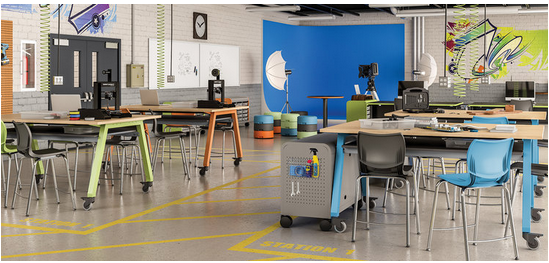

Recently we hosted the WCED eLearning ‘Empower Hour’ conversations and the topic ‘Classroom Transformation; the rationale for integrating existing technology into classroom practice’, came under the spotlight. Most of us might have been exposed to this issue and may have encountered various viewpoints on this, but what made this instance memorable, was the different perspectives shared by the panel. These ranged from EdTech availability, to the value that EdTech can bring to the classroom, to the role of the educators and what all of this holds for the future for ICT integration into the curriculum.
The now well-known saying of Ignacio Estrada: “If a child can't learn the way we teach, maybe we should teach the way they learn”, basically broke down the door for ICT innovation in the classroom. When it comes to change over the past hundred years or so, education is guilty as charged; it is one of the slowest changing industries. If one just look at the seating arrangements of the majority of classes today, it still smacks of that assembly line feel that was so evident in the previous industrial revolution, where production was the order of the day, confining you to your space of work. The fact that faith-based organisations recently were quicker than education to adapt to livestreaming to get their message across, is further testimony to this. This in spite of all the great advances made in the field of educational technology over the last 30 odd years.
Breaking out into the latest TikTok dance craze with your learners to summarize that poem, or belting out that science formula in Amapiano fashion, is fine and dandy. Learners love this, but we must ensure that the tail (teaching strategy) is not wagging the dog (what is to be learned and understood).
Being innovative with technology can mean different things to different people and the above might be seen as a flimsy view of innovation. What it all boils down to is that we must ensure that that which we seek to innovate, has a lasting positive effect and that it brings about a profound way of teaching and learning.
It might sound farfetched, but if one positive could be attributed to the COVID pandemic, it surely must be that it has propelled us to come up with novel ideas on how we could keep on delivering curriculum amidst the pandemic. The ubiquitous WhatsApp group immediately jumps to mind. Equally it would also be quite a setback if we return back to our old ways when everything becomes “normal” (if there is, or will be such a thing). We just have to innovatively keep on keeping on to transform our classrooms into becoming those digital hubs of learning and teaching.
Harnessing the available EdTech at schools so that it’s affordances can be fully exploited, surely needs to be constantly visited and revisited. In the same breath, we also have to acknowledge that not all schools have the same access to EdTech due to various reasons, but plans are afoot. Hope springs eternal.
Those schools sporting internet coverage and a variety of EdTech, should really be asking the following questions:
- Are we using these technologies to their full potential?
- How does our educational practices align with these technologies?
- How is it enhancing our learning and teaching?
These EdTech tools can surely transform our classrooms in many ways. As one of the panelist on the aforementioned empower hour session noted, “these tools can motivate and engage your leaners, it can contribute to real world problem solving and also lead to the creation of new knowledge” Isn’t this part and parcel of 21st century learning? Isn’t this what we seek to achieve in preparing our leaners for a different world than today?

To transform that classroom, there needs to be someone who’s driving it. The educator is seen as the change agent who must have the necessary skillset to bring about that transformation.
Long gone are the days of knowing the curriculum like the back of your hand and just “doing it” year in and year out. It is thus best that the educator is up to the task and skilled in using appropriate and available EdTech and bringing about change. Simply put in another way: while technology will not replace teachers, teachers who use technology will replace those who do not.
Educators must be given the opportunity to upskill or take the lead themselves by studying further. It can only bode well for both the professional development of the educator as well as for the bigger improvement plan of the school.
By improving yourself, it also allows you to critical look at what is working or not working in your classroom. Constantly we hear: “One size does not fit all” when it comes to EdTech integration. This is so true and having that discernment to reflect upon past practices and assessing critically what you believe about EdTech integration, can only make way for improved and innovative teaching and learning.
It is also not impossible, but seldom does it happen that one transformed classroom becomes so infectious that the whole school undergo sweeping changes when it comes to EdTech integration. Here school management should step up to the plate and through careful planning and with everyone involved, bring about that change. This is a critical point if we want to see school wide EdTech integration becoming a reality. We need to avoid exposing our leaners to a tech rich environment one year, only for them to step into the next grade, with zero exposure to tech. It’s also similarly very disheartening to see that within the same grade at the same school that one set of learners having a field day with tech integration only for their counterparts next door dealing with the same concepts and not experiencing the same joy and fun. We have to do away with the notion that we are trying to teach 21st century skills with a 20th century mindset.
Two aspects mentioned in the Horizon report of 2021 is the coming widespread adoption of hybrid learning models and the increased use of learning technologies, all of this brought about due to the impact of the COVID pandemic. It seems that we cannot argue this away and should rather ensure that our schools, and more specifically our classrooms, are transformed and ready for this new normal.
“Transformation is a process, and as life happens there are tons of ups and downs. It’s a journey of discovery – there are moments on mountaintops and moments in deep valleys of despair.” Rick Warren
Sammy Bouwers
eLearning Advisor
Eden and Central Karoo District
Do you have an educational app, video, ebook, course or eResource?
Contribute to the Western Cape Education Department's ePortal to make a difference.


